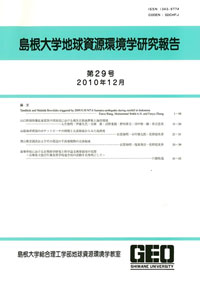島根大学総合理工学部地球資源環境学教室
ISSN:1343-9774

ダウンロード数 : ? 件
この文献の参照には次のURLをご利用ください : https://ir.lib.shimane-u.ac.jp/6137
島根大学地球資源環境学研究報告 22
2003-12-27 発行
Grain fabric of Bouma A and B divisions deposited from surge-like turbidity currents: an example from the Plio-Pleistocene Kakegawa Group, Japan
ファイル
内容記述(抄録等)
The grain fabric of the massive Bouma A division of a turbidite bed from the Plio-Pleistocene Kakegawa Group,Shizuoka,Japan is analyzed in detail.The bed is interpreted as having been deposited on the levee of a small submarine channel,and consists of a T_<a-d> Bouma Sequence thinning in the down-current direction in a ~15 m-wide outcrop.This feature indicates that the flow waned rapidly away from the channel.
The grain fabric of the A and B divisions analyzed in horizontal intervals of 0.4 mm and 0.2 mm,respectively,can be characterized as follows:(1)The lower part of the A division is dominated by down-current imbricated intervals,and the
corresponding rose diagrams have large circular variance.(2)The upper part of the A division is characterized by both down−current and up−current imbricated intervals,although the latter is dominant,and highly inclined grains tend to be less common.(3)The B division is represented only by up-current imbricated intervals.These results are similar to those derived from fabric analysis of experimental gravity flow deposits,except for the dominance of down-currrent imbricated intervals in the lower part of division A.The down-current imbricated intervals are interpreted as having being formed by shear oscillation in the basal high-density flow layer(i.e.,a quick bed),as observed in flume experiments.The prominence of the down-current imbricated intervals in the natural turbidite beds compared to those seen in experiments is probably due to the larger flow scale.These results also suggest that paleoflow analysis based on the grain fabric of division A may give incorrect flow directions in some turbidites.For improved reliability of paleoflow analysis,flow directions should be determined from a combination of paleoflow indicators.
The grain fabric of the A and B divisions analyzed in horizontal intervals of 0.4 mm and 0.2 mm,respectively,can be characterized as follows:(1)The lower part of the A division is dominated by down-current imbricated intervals,and the
corresponding rose diagrams have large circular variance.(2)The upper part of the A division is characterized by both down−current and up−current imbricated intervals,although the latter is dominant,and highly inclined grains tend to be less common.(3)The B division is represented only by up-current imbricated intervals.These results are similar to those derived from fabric analysis of experimental gravity flow deposits,except for the dominance of down-currrent imbricated intervals in the lower part of division A.The down-current imbricated intervals are interpreted as having being formed by shear oscillation in the basal high-density flow layer(i.e.,a quick bed),as observed in flume experiments.The prominence of the down-current imbricated intervals in the natural turbidite beds compared to those seen in experiments is probably due to the larger flow scale.These results also suggest that paleoflow analysis based on the grain fabric of division A may give incorrect flow directions in some turbidites.For improved reliability of paleoflow analysis,flow directions should be determined from a combination of paleoflow indicators.
Other Article
PP. 93 - 105
PP. 107 - 110
PP. 111 - 120
PP. 121 - 133
PP. 161 - 166
PP. 167 - 172
